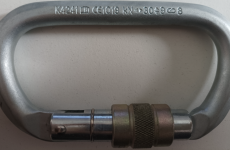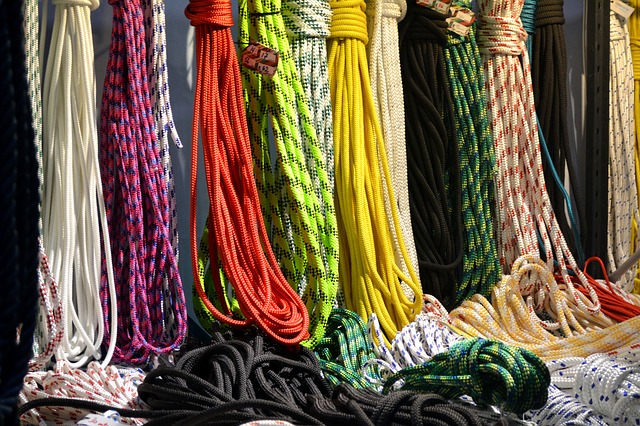
So you want to start climbing some rock climbing routes outdoors, and you may be wondering about the gear you’ll need to bring.
If you started lead climbing in the gym, normally the ropes are all set up for you with an attached belay device on a carabiner for you to clip into your harness. The routes at the gym probably already had draws clipped into the bolts for you to clip your rope into.
When you go sport climbing outdoors, you’ll need to not only bring your shoes, harness, chalk bag, rope, and belay device, but it’s time to add some quickdraws to your ever-growing collection.
What is a carabiner?
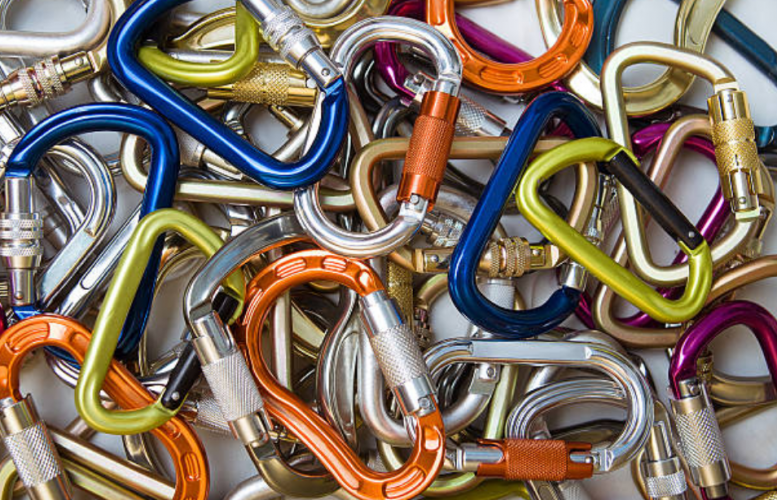
A carabiner is a strong metal loop with a gate. Carabiners are one of the most vital pieces of rock climbing and mountaineering equipment that there is. They come in many different sizes, shapes, weight, and variations.
Carabiners have many uses, even outside of rock climbing, but the type and purposes that we are going to be focusing on today are the asymmetrical D-shaped carabiners most commonly used in rock climbing gear for sport climbing outside.
How strong are carabiners?
A carabiner’s strength is measured in kilonewtons. They are certified for a minimum of 20kn, but if used properly, any climbing fall is never going to come anywhere near that level of force.
Always buy carabiners from reputable climbing companies, who you know have been certified by the UIAA to test using UIAA standards for Certified Equipment (CE). The certifications ensure that they are much stronger than any force from a climbing fall is going to put on them.
Without going into too much physics, one thing to understand is that the gate is the weakest part of a carabiner, and that a carabiner is weaker when it is opened than when it is closed. There is still more to understand about gates though, as you will notice that the carabiners have different shaped gates.
Gate Shape
Let’s take a look at the two main different shaped gates of carabiners used for sport climbing in a little more detail:
Straight Gate Carabiners

These carabiners are used to clip into the bolt on the wall. On a quickdraw they will be at the top. It makes the most sense to hang all your quickdraw on your harness by the straight gate carabiner. Then, when you unclip them from your harness, they are ready to clip into the bolt with your same hand.
Bent Gate Carabiners
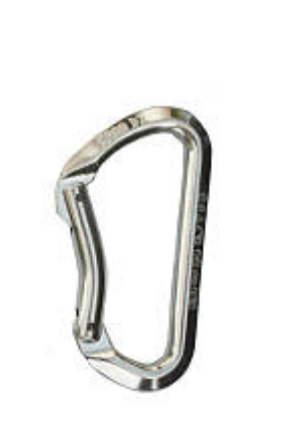
The bent-gate carabiner is used for the side of your quickdraw that the rope clips into. It’s a bit easier to make contact with the gate of the carabiner when there is a slight inward bend to the gate. Once the rope is inside, there is a little less room inside for your rope to move around than there would be with a straight gate.
Gate Design
Now that you understand the difference between straight gate and bent gate, the decision to make is between the design of that gate. Those gates are either going to be a solid tube, or a steel wire.
Solid Gate Carabiners
Solid gate carabiners are very common and they have a metal tube for a gate that is about the same thickness as the rest of the metal loop of the carabiner itself. It’s also possible concern for the gates to open when in use, or more specifically, for the bent gate carabiners to “flutter” when the rope is in them.
The Petzl Spirit Straight Gate Carabiner is a popular carabiner that was designed specifically for sport climbing. The gate snaps nicely in to place and there is a slight thumb indentation on the gate that assists you in getting your hand it in the right spot to clip into the bolt.
The Petzl Spirit Bent Gate Carabiner is wide and smooth on the inside so that your rope will easily glide through it once it’s clipped in.
Wire Gate Carabiners
Carabiners with a loop of wire that springs shut are generally lighter than solid gate carabiners. It may look like a wire gate isn’t as strong as a solid gate, but they actually are, and some of them are stronger. Some climbers will only use wire gate carabiners because of this increased strength in the gate, which is the weakest part of a carabiner. They also snap shut and have a better chance of not opening than solid gate carabiners. However, some of them have notches, which some people prefer, but others dislike notches because they can catch the rope.
There are different varieties of wire gate carabiners so let’s take a look at a couple of the popular ones.
The Black Diamond Neutrino Carabiner is a full-strength carabiner that is small and light. One of the greatest benefits for climbers is the price of this carabiner.
Black Diamond doesn’t currently have a set of pre-made quickdraws assembled using these carabiners, but you can DIY a set of quickdraws. These are also great for keeping a couple spare ones on your harness for emergencies such as needing to bail out of a route before you reach the anchors.
The Mad Rock Ultra Light Bent Gate Carabiner is popular due to its light carrying weight, and great design. It is bigger than most ultra-light carabiners, making them easier to handle. It is also one of the more cost efficient carabiners that doesn’t sacrifice strength or quality.
Locking Carabiners
Carabiners with locking gates can have different ways of locking. The most common gate locking mechanisms are the the screw-lock, and the twist-lock.
Locking Carabiners are most commonly used on your harness to connect your belay device. They are normally a pear shape, where the small end attaches to your harness and the wider end give you more room for motion with the side that is attached to your belay device.
From the same line as the straight gate and bent gate carabiners from Petzl that we love so much, comes their screw-lock carabiner. This carabiner was similarly engineered for sport climbing.
It is very easy to lock and unlock, you can do it easily with just your thumb. It has red coloring underneath the screw-lock gate, which is visible only when the carabiner is not locked. This makes it visually easy to be reminded to lock it.
The Petzl Pro Spirit Screwlock Carabiner is so easy to use that it can be used for clipping, but is very popular as a biner to attach your belay device securely to your harness.
The Metolius Gatekeeper Belay Biner is an excellent carabiner to use as a dedicated carabiner for your belay device. It includes a second gate internally that allows you to snap the belay device into place easily. It assures that the carabiner is loaded properly along its strongest axis.
The Black Diamond Gridlock Screwgate Biner is a popular choice for a belay carabiner due to its unique shape and internal gate to keep the device in place. It is a little more complex to load and attach this carabiner due to the gates being attached. It’s easy to load but you have to open the gate twice to get it fully unattached. It is still a great locking carabiner and the shape of it gives a great range of movement while belaying.
What is a quickdraw?
A quickdraw is simply two carabiners attached by a thick band.

Quickdraws are used to secure your rope to the bolts in the wall while you climb. As you climb the routes, you will first attach one end of the quickdraw to the bolt, and then clip your rope into the other end of the quickdraw. You will need to retrieve them all when you’re finished the climb too.
The main differences between different types of quickdraws are the size and shape of the connecting fabric, and the type of carabiners used.
How many quickdraws should I get?
It depends. Most people go with 10 or 12, but know the area you’re planning to climb in. Look at the guide books for the crag you’re visiting and most of them will list the number of bolts on each route. It’s also good to have a spare or 2.
Keep in mind that sometimes you will need two for the anchor at the top of the route.
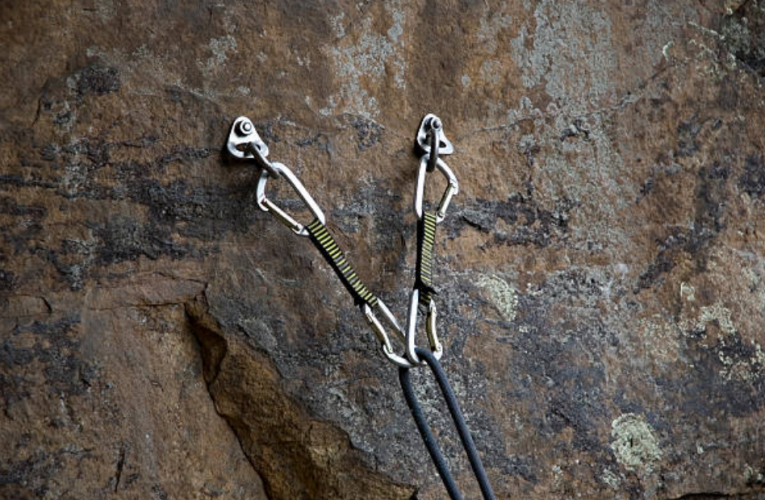
Best Quickdraws For Sport Climbing
Some people will always prefer the smallest and lightest quickdraws they can find so that you’re not weighing yourself down when you climb. Some may prefer larger bands so that they are easier to hold and manage while clipping. Others prefer smaller bands. It is going to come down to mostly personal preference. Just knowing what is out there will help you decide what’s the most important to you, so here are some of the best selling quickdraw to give you an idea of your options.
Climbers love the Petzl Spirit Express Quickdraw because they’re easy to grab, and the clipping action is very smooth.
Weighing 3.3 oz each, they’re not ultralight, but they’re not so heavy that a full set on your harness will weigh you down either.
They are available in two different lengths: Petzl Spirit Express Quickdraw – 12cm and Petzl Spirit Express Quickdraw – 17cm.
Unless you are looking for a very small quickdraw, these are especially great for beginners due to their ease of use.
If you prefer wire gate carabiners, which many climbers do, the Black Diamond Freewire Quickdraw is one of the most popular.
It has a large band, which makes it easy to grab and control. However it is also fairly heavy, almost 100 grams, which is on the higher end for weight.
Another concern to note is that the bottom carabiner has a hook at the top of the gate, which some people will complain causes the rope to snag and makes it more difficult to remove the rope. However once you get used to the hooked gate, you may or may not find this to be an issue.
They are available in two different lengths: Black Diamond FreeWire Quickdraw – 12cm and Black Diamond FreeWire Quickdraw – 18cm.
This is a very reasonably priced quickdraw, and is usually the top choice for those that can’t or don’t want to spend a lot of money buying a full set of quickdraws.
The Metolius FS Mini II Quickdraw is one of the smallest and lightest quickdraws available. Each draw weighs only 45 grams. It’s great to reduce the size and weight of all the gear you’re carrying in to the crag.
The carabiners are very small, but they are full strength. These draws also don’t take up very much space on your harness.
They are not as easy to grab as larger quickdraws, but these have a great feature called the “Jig” which helps keep the carabiner stable to make it easier to clip in to the wall. Once you get used to them, they are very enjoyable.
If you are concerned about keeping the weight down when climbing and porting your gear, or if have small hands, you might want to get a set of these.
This article was meant to give you a good background to understanding carabiners and quickdraws for sport climbing. We hope it will help you make the right decision before you pick up enough gear to get up your first outdoor route.
